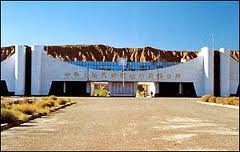
 China Tours
China Tours Tibet Tours
Tibet Tours China Theme Tours
China Theme Tours Off The Beaten Track
Off The Beaten Track Yangtze Cruises
Yangtze Cruises China Trip Planner
China Trip Planner Travel Agents
Travel Agents


We had a wonderful time in Tibet. We have learned a lot about this unique destination because of the wonderful guide Degyi who is so knowledge and always available towards our tours. We stayed at the Shangri-La Hotel Lhasa, and we would never imagine a Tibet travel could be so nice and amazing without the help of Degyi.
Also, thanks a lot to our Tibetan driver Mr.Wongdun for his safe driving and a good sense of service along the way.
We shall return Tibet in the near future!
P.B. and A. A - Europe
Tibet Travel
June 2018 (Private Tibet Journey from Kathmandu)

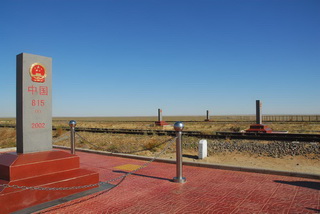 Tour Name: Drive the Ancient Silk Road in China Tour Name: Drive the Ancient Silk Road in ChinaTour Code: M75D359 Duration: 24 Days & 23 Nights Destination: Tourgart (Kyrgyzstan), Kashgar (China), Khotan, Mingfeng, Korla, Turpan, Dunhuang, Jiayuguan, Zhangye, Lanzhou, Xi'an, Luoyang, Pingyao, Taiyuan, Datong, Beijing, Erenhot Features: The Silk Road is the world's most famous trade route. This exciting driving journey follows the path of the ancient Silk Road from the far west Kashgar to Xian, the eastern terminus. As part of trans-Asian self driving, you will have a unique experience in China. Go and drive your Silk Road! Departure Date: You Choose! Tour Price: From $ P.P |
||
|
Itinerary Day By Day: | ||
| Day02 Kashgar (B, L, D) 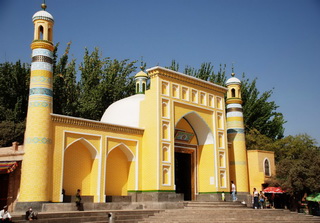 A full day guided tour in Kashgar. You will visit Idkah Mosque, the Abakh Khoja Tomb, Sunday Bazaar, the old town and Kashgar Silk Road Museum. Idkah Mosque is known for being the largest and oldest mosque in China that invites about 10,000 worshipers on every Friday. Abakh Khoja Tomb that is better known by the Chinese as Tomb of Fragrant Lady is an ancient Islamic building, where five generations of a famous Islamic master were buried. The Sunday Bazaar in Kashgar is perhaps the largest road market in Central Asia, the trip to the Bazaar offers you a good chance to experience the very good touch to the vibrant city with its local residence. After that you will explore the Old Town of Kashgar to observe these time-aged houses and people's daily life. Overnight at Barony Hotel Kashgar | ||
| Day03 Kashgar - Khotan (B, L, D) 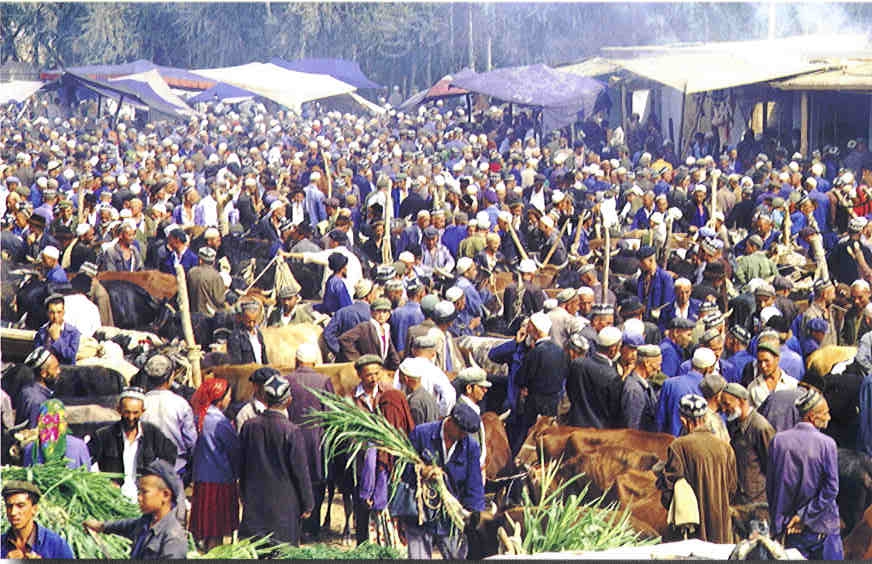 Check out in the morning and leave for Khotan. The 520-kilometer journey, dotted with Gobi, desert and oasis, will take you about 7 hours by car. On the way, you could see the Yingisar Uigur Pocket-Knife Workshop and the 500-year Yarkant King Mausoleum in Shache County (or Yarkant County). Overnight at Zhejiang Hotel Khotan | ||
| Day04 Khotan - Mingfeng (B, L, D) 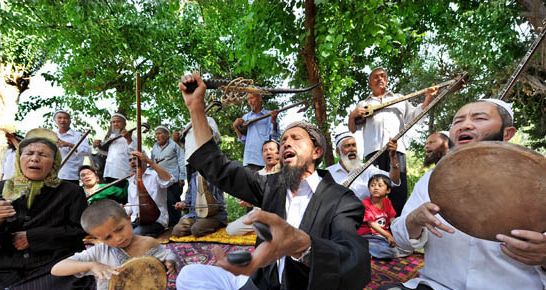 This morning you will visit a Silk Workshop you will see how silk is produced from the cocoons of silk worms, and turned into the beautiful fabric. Then you drive to Mingfeng 3.5 hours (300 kilometers). While passing by Yutian County, you can visit a local bazaar and see the unique minority people's costume. You will also visit a local family. Overnight at a local hotel | ||
| Day05 Mingfeng - Korla (B, L, D) 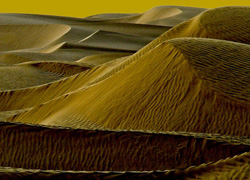 Today you will drive across the Taklamakan Desert to Korla (780km, approx.9 hours). Located in the middle of the large Tarim Basin, Takla Makan is the largest desert in China with shifting dunes and poplar forest. In Uigur language, Takla Makan means 'you can get into it but can never get out' and the desert has another name 'the Sea of Death'. Later of the day you arrive in Korla and have a good rest. Overnight at Garden Hotel Korla | ||
| Day06 Korla - Turpan (B, L, D) 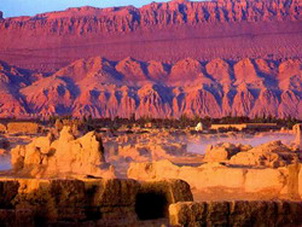 Today you will leave for Turpan. On the way you could visit Lake Bosten. Bosten Lake is the largest lake in Xinjiang and one of the largest inland freshwater lakes in China. Then you will be transferred to Turpan the hottest, driest and lowest place in China, average temperature can be reached nearly 48 during the July. Overnight at Jiaohe Manor Hotel | ||
| Day07 Turpan - Hami (B, L, D)  Drive to Hami today. On the way you will stop for sightseeing in and around Turpan. The tour covers the Bezkelik Thousand Buddha Caves, Flaming Mountain and Astana Tomb. The Bezeklik Thousand Buddha Caves are complex of Buddhist cave grottos dating from the 5th to the 13th centuries. These caves were built on a cliff face fronting a river valley. In the Uigur language Bezeklik means "place where there are paintings". These caves are one of the largest Buddhist "grotto" sites in Xinjiang. It used to be an important center for Buddhist worship under the Xizhou Huigu government of Gaochang Kingdom, which built the royal temple of the King of Huigu at this site. Flaming Mountain is about 10 kilometers east of Turpan, stretching up to 100 km from east to west and about 10km from south to north. With an average temperature of 30 degrees, it is known as the hottest place on earth and the highest temperature can reach 47.8 Celsius degrees. Nicknamed "underground museum", the Astana Tomb Complex contains a total of over 500 tombs, the occupants of which include aristocrats, officials and ordinary people from the early Western Jin Dynasty to the mid-Tang Dynasty. Due to the high terrain and hot and dry weather in the area, the tomb chambers are naturally germ-free. As a result, mummies and burial objects inside are well preserved after thousands of years, and a large number of historical relics are kept intact, including silk fabrics, murals and pottery ware etc. Overnight at a local hotel | ||
| Day08 Hami - Dunhuang (B, L, D) 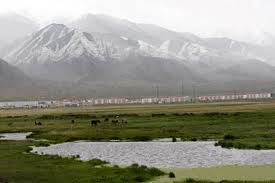 Morning visit Kumul Muslim King Tomb, a famous Islam construction in Xinjiang, then you shall drive to Dunhuang. Overnight at Silk Road Hotel | ||
| Day09 Dunhuang (B, L, D) 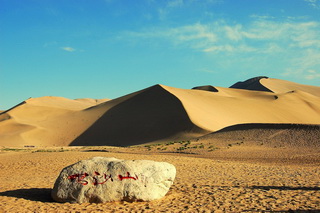 A full day guided tour in Dunhuang to visit Mogao Caves, also known as the "Dunhuang Grottoes" or the "Thousand Buddha Grottoes", is located on the western cliffs of the Echoing Sands Mountains. It is one of the most complete collections of Buddhist frescoes and sculpture from a period ranging over ten dynasties. Their construction started in 366 AD. The existing 492 grottoes contain 45,000 square meters of murals and more than 2415 painted sculptures, which spanned 10 consecutive dynasties in more than 1,000 years. Then you will visit Crescent Spring (Yueya Quan) is in the Echoing Sand Mountains (Mingsha Shan), 6 km (4 mi) south of Dunhuang. It is an oasis in the desert. The spring's name derives from the crescent-shaped lake formed by the spring water between two huge sand dunes. Although the area is very dry, the pool doesn't dry up as one might expect. Afterwards you will enjoy an experience of riding the camel. Riding a camel on the desert of the Echoing Sand Mountains is a great experience. You can enjoy the beautiful wavy shapes of the smooth yellow dunes against the deep blue sky, and imagine you are traveling the ancient Silk Road. Step off the camel and listen for the singing of the sand. Overnight at Silk Road Hotel | ||
| Day10 Dunhuang - Jiayuguan (B, L, D) 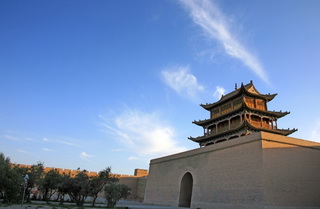 Drive along the Hexi Corridor to Jiayuguan, visit Jiayuguan Pass. Reputed as 'the Greatest Pass under Heaven', Jaiyuguan Pass is one of the most important and majestic military fortresses along China Great Wall. Your next stop is the Overhanging Great Wall was built during the Ming Dynasty (1368-1644). Overnight at Hua Yuan Hotel | ||
| Day11 Jiayuguan - Zhangye (B, L, D) 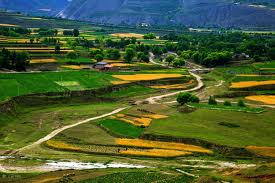 The Overhanging Wall gets its name because there is a 231 meter long section, with an obliquity of 45 degrees, built onto a 150m high ridge. From a distance, it is said to resemble a dragon about to extend its body towards the ground. Then proceed to the Wei-Jin Art Gallery. Namely Wei-Jin Mural Brick Tomb, it is a huge tomb group of more than 1,400 tombs built between the 3rd and 5th century during the Wei and Jin dynasties. Regarded as the largest subterranean gallery in the world, it houses vast collection of murals which reflect the unique culture about 1,500 years ago. The Tombs of Wei and Jin Dynasty in Jiayuguan is also worthy a visit. Drive to Zhangye in the afternoon. Overnight at Tianyu Int'l Hotel | ||
| Day12 Zhangye - Lanzhou (B, L, D) 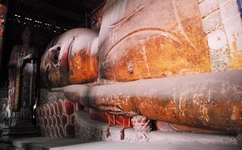 Drive to Lanzhou, the provioncal capital of Gansu. On the way you will visit Giant Buddha Temple in Zhangye and Temple of Confucius in Wuwei. Overnight at Lanzhou Legend Hotel | ||
| Day13 Lanzhou - Xian (B, L, D) 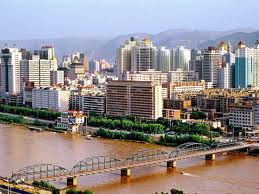 Drive to Tianshui for the Maiji Grottos, then eastwards to Xian. The landscape around Maiji Mountain is very beautiful, with green cypresses and pines, wild flowers and flourishing grass on the chain of mountains. Jutting straight-up out of the surrounding landscape, Maiji Shan was accessible by a series of stairs once joined to its side by logs thrust like pegs in holes carved out of the rock face. In modern times this series of wooden stairs has been replaced by metal ones and a new adhering material has been applied to the face of the mountain. The grottoes were cut during a period of 1,500 years from the Later Qin Dynasty (384-417) up to the Qing Dynasty (1644-1911). During an earthquake in the seventh century, the cliff broke in two and the grottoes were thus divided into east and west sections. The 194 remaining grottoes today contain a total of seven thousand clay and stone statues and 1,300 square meters of mural paintings. The sculptures representing celestial figures portray them as real people, full of life and energy. Overnight at Grand New World Hotel | ||
| Day14 Xian (B, L, D) 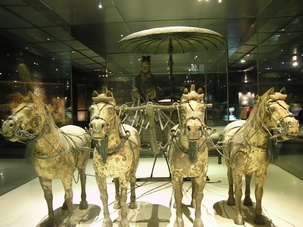 Your Xian tour begins with the mighty Terra Cotta Warriors and Horses. Discovered in 1974, Xian Terra Cotta Warriors and Horses Site is one of the most important archaeological finds in the 20th century. In a vault of approximately 12,000m2 and 5m underground lay some 8,000 terracotta infantry soldiers, archers, cavalrymen and chariots arranged in battle formation, ready to defend their emperor's immortal soul. After the visit you will have a very good local lunch at a graceful restaurant. Then you will head back town and visit the Big Wild Goose Pagoda. Situated inside Ci'en Temple (4 kilometers south of Xi'an City), it is one of the famous Buddhist pagodas in China. Sponsored by Tang Emperor Gaozong (628-683, reigned 650-683), the temple was first built in 652 during the Tang Dynasty as a symbol of thanksgiving to his mother for her kindness who had suffered an early death. Overnight at Grand New World Hotel | ||
| Day15 Xian - Luoyang (B, L, D) 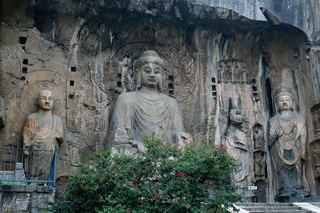 Drive to Luoyang. On arrival, you will proceed to visit one of the important destination in the area, the Longmen Grottos. Longman Grottoes, located 13 Km to the south of Luoyang, are a treasure house of ancient Buddhist cave art. The grottos were hewed and carved during the Northern Wei Dynasty (386-534), when the rulers relocated their capital at Luoyang near the end of the 5th century. At that time Buddhism was spreading east into China and was venerated by the imperial court. The Buddhists adopted the practice of carving rock temples, dedicated to the Buddha. Overnight at Peony Plaza Hotel | ||
| Day16 Luoyang (B, L, D) 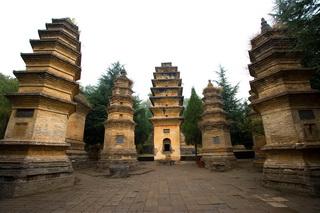 Today's activity will be at Dengfeng for its renowned Shaolin Temple and Songyang Academy. Founded in AD 496 during the Northern Wei dynasty, the Shaolin Temple was built in honor of an Indian monk called Bodhidharma (known to the Chinese as Da Mo), founder of the Mahayana sect of Buddhism or more popularly known as Chinese Chan (or Zen) Buddhism. This temple is therefore regarded as the birthplace of Chinese Buddhism. The temple, which bore witness to the rise and fall of several dynasties, is also famous for its Martial Arts (Kung Fu). Shaolin Kung Fu is the product of the synthesis of other martial arts principles into a distinctive martial art style. Besides, visit to the ancient Songyang Academy, located at the foot of Mt.Song Shan (Song Shan Mountain), which is one of the four most famous institutions of higher education in ancient China. Overnight at Peony Plaza Hotel | ||
| Day17 Luoyang - Pingyao (B, L, D) 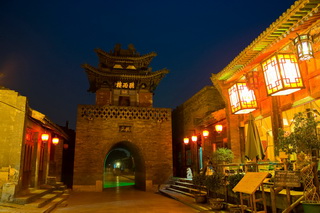 Drive north to Pingyao and walk in the Ancient City of Pingyao. Pingyao Ancient Town is an ancient county typical of rural counties in North China, simple and steeped in ancient tradition. The Old Town of Pingyao was constructed according to the traditional planning and building style of the Han ethnic group and was laid out according to the functions of its different parts. Four large streets, eight smaller ones, and 72 lanes made a neat grid. Symmetrically arranged along an axis, the private houses were constructed either in the style of courtyard houses or in the style of manmade-cave houses, all with local features. Overnight at De Chao Ge Hotel | ||
| Day18 Pingyao - Taiyuan (B, L, D) 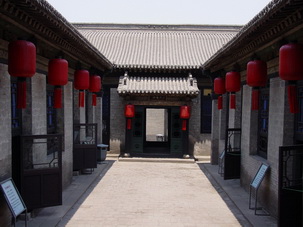 Head to Taiyuan, the provincial capital. On the way visit Qiao Family Compound and Ji Ancestral Temple. Jin Ci (Jin Ancestral Temple) is a good combination of historical cultural relics and beautiful landscapes. The welcoming boughs of a multitude of ancient trees provide an amazing entrance to the temple. Beyond this, the numerous halls, cabinets, pavilions and bridges are guaranteed to keep any visitor enthralled. Overnight at Shanxi Grand Hotel | ||
| Day19 Taiyuan - Datong (B, L, D) 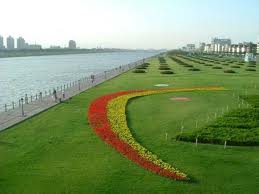 Drive to Datong, on the way discover some of China's ancient architecture complex such as Wooden Pagoda and the Hanging Temple. The Hanging Temple is an architectural wonder. It was built on a cliff face. The building complex was built on the base of the natural hollows and outcrops along the contour of the cliff. Over 40 halls, cabinets and pavilions within an area of 152.5 square meters are connected each other by corridors, bridges, boardwalks. They are evenly distributed and well balanced in height. The Wooden Pagoda is another must-see attraction for any tours to Datong. The Pagoda, built completely of timber, and standing 67.31 meters high, is the only extant large wooden pagoda in China and also the tallest among ancient wooden buildings of the world. Overnight at Datong Garden Hotel | ||
| Day20 Datong - Beijing (B, L, D) 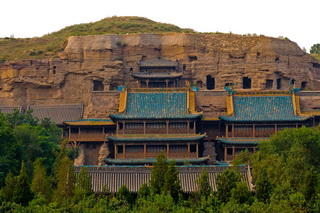 In the morning you will drive to explore Yungang Grottos. Yungang Grottoes, are ancient Buddhist temple grottoes near the city of Datong in northern China's Shanxi Province. The four main sites in China that are famous for their stone sculpture are Dunhuang, Longmen, Yungang and Dazu. Among these, the Yungang grottoes are considered first among equals, for their tremendous size, their ancient history, and their relatively complete state of preservation. In 2001 the site was listed as an UNESCO World Cultural Heritage Site. Besides, you will also visit Huayan Temple and the Nine-Dragon-Wall, one of the four nine-dragon-screen-walls in China. In the afternoon you will drive to Beijing and visit the Great Wall at Badaling. Overnight at Jianguo Hotel Beijing | ||
| Day21 Beijing (B, L, D) 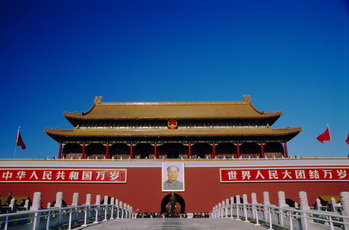 Today you will have a day leisure tour in Beijing to visit the Tiananmen Square, Forbidden City and the Summer Palace. Tiananmen Square is probably the biggest one of its kind in the world. From here you will go on to the Forbidden City (also known officially as the Imperial Palace Museum ) was commissioned by the third Emperor of the Ming Dynasty, Emperor Yong Le. The palace was built between 1406 and 1420, but was burnt down, rebuilt, sacked and renovated countless times, so most of the architecture you can see today dates from the 1700's and on wards. The Forbidden City was the seat of Imperial power for 500 years, and is now a major tourist attraction in China. Located at the northwest suburb of Beijing, the Summer Palace was originally a royal garden and a temporary dwelling palace for emperors of Qing Dynasty, Its predecessor was the Garden of Clear Ripples (Qingyiyuan) started in 1750 and burned down by the British and French allied troops in 1860. In 1886, Empress Dowager Cixi used navy outlays and other funds in the reconstruction and renamed the park as Summer Palace in 1888.The Summer Palace in northwest suburban Beijing is the largest and most complete imperial garden existing in China. Overnight at Jianguo Hotel Beijing | ||
| Day22 Beijing - Ulanqab (B, L, D) 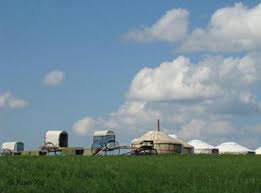 In the morning you will drive to the Temple of Heaven to watch the morning Tai Chi exercise by the locals, then head out to Ulanqab (Jining Town). Overnight at a local hotel | ||
| Day23 Ulanqab - Erenhot (B, L, D) 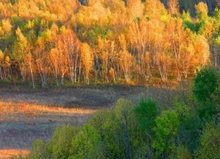 Drive to Erenhot, the Chinese border town with Mongolia. Overnight at a local hotel | ||
| Day24 Erenhot (B)  You will cross the border control and drive into Mongolia, your driving journey through China ends here. | ||
| Tour costing varies upon group size, travel season and hotel accommodation levels etc. For price details please email us at info@splendidchinatours.com. Price inclusions: | ||
China Trip Planner | Travel Agents | About Us | Why Us | Contact Us | How to Pay | How to Book - Terms & Conditions | Site Map
Copyright © 2010 - 2030 All Rights Reserved.


 0086-28-85711328
0086-28-85711328 0086-28-85546015
0086-28-85546015






